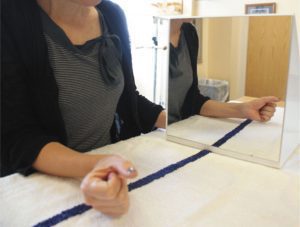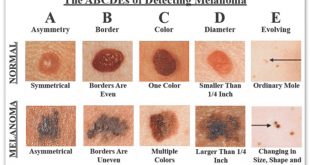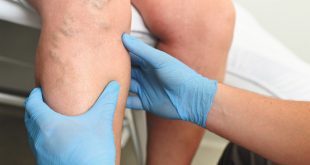 Mirror Therapy (MT) is an occupational therapy technique used to help increase motor function and decrease pain in a limb, such as in your hand or wrist. The principle of MT is the use of a mirror to create a reflective illusion of the affected limb in order to trick the brain into thinking movement has occurred and without pain.
Mirror Therapy (MT) is an occupational therapy technique used to help increase motor function and decrease pain in a limb, such as in your hand or wrist. The principle of MT is the use of a mirror to create a reflective illusion of the affected limb in order to trick the brain into thinking movement has occurred and without pain.
Although initially developed for amputees to control phantom limb pain, it is now commonly used for many different conditions, including stroke rehabilitation, complex regional pain syndrome (CRPS), arthritis, and other chronic pain conditions in the limbs.
The Brain and Pain: Research tells us there’s a complete map of the body’s surface in the brain. After a limb injury or in the case of chronic pain in the hand or wrist, the area in the brain mapped to that limb holds on to the memory of the pain. The brain learns to associate movement of the limb to pain, sometimes well after the injury has resolved. This is called, “learned pain”. MT uses a reflective illusion of an affected limb in order to trick the brain into thinking movement has occurred without pain and to create positive visual feedback of limb movement.
Mirror Therapy: The device is simply a mirrored box positioned so that your unaffected hand is outside of the box and can be visibly seen as a reflection in the mirror. The affected hand is covered and positioned out of site. The Occupational Therapist will guide you through slow and repetitive hand and wrist exercises of the unaffected hand, while encouraging you to focus on the reflection in the mirror. The goal is to envision that the hand in the reflection is your affected hand. Exercises may include making and releasing a fist, turning your palm up and down, moving fingers individually, or grasping items like a coin or a water bottle.
Mirror Therapy and the Brain: From the reflective illusion, the brain is tricked into “seeing” the affected limb moving without pain. With continued practice, the brain will “learn” that your limb is healthy and, therefore, will start to move it more easily.
If practiced regularly, MT has helped many people control their pain independently. Occupational Therapists suggest practicing 3-5 sessions a day for up to 30 minutes each. Once learned, the therapy can continue in your home environment.
Innovative Therapies Group
If you often experience pain, stiffness, immobility, or balance issues, being proactive about physical therapy treatments and techniques can help to alleviate or lessen these circumstances.
For patients suffering from pain, the first step to recovery is to receive a proper diagnosis so the cause of the symptoms can be determined. Physical therapists are trained to administer flexibility and strengthening tactics along with body mechanics and awareness techniques to get your body moving and creating a much less painful range-of-motion. With ongoing therapy, most people see remarkable outcomes and lasting results.
Innovative Therapies Group offers Hand Therapy Specialists, Occupational Therapy, Physical Therapy, Speech Therapy and Massage Therapy. They embrace alternative methods and will help you explore new inventive ways to combat your pain or disorders.
Types of Treatment Available with Physical Therapy
• Assessment and Evaluation Programs
• Difficulty Walking
• Fall Prevention and Balance Retraining
• Fitness and Wellness Programs
• Functional Training
• Gait Training and Balance Programs
• Manual and Massage Therapy
• Neurological and Neurodegenerative Retraining
• Vestibular Rehabilitation
Innovative Therapies Group, Inc.
352-433-0091 | innovativetherapiesgroup.com
 Central Florida Health and Wellness Magazine Health and Wellness Articles of the Villages
Central Florida Health and Wellness Magazine Health and Wellness Articles of the Villages



